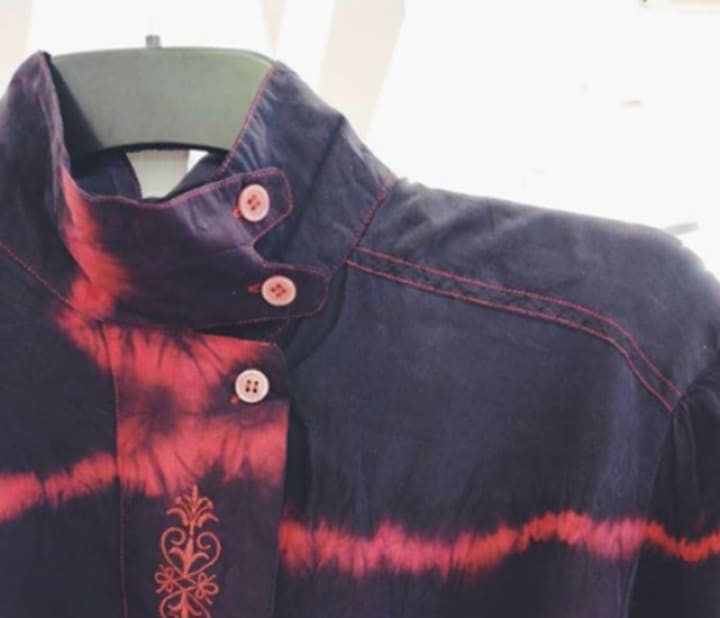The True Cost of Your Wardrobe
How the Fashion Industry is Destroying the Planet–and What We Can Do to Help

When you think about the fashion industry, "climate crisis" probably isn’t the first thing that comes to mind. In fact for many people, the two barely link. In this age of cheap clothing where you can essentially bulk-buy items to always have a different outfit of the day, almost everybody has a wardrobe full of clothes they seldom wear. Whether they are branded or made to a higher quality, whether they are from eBay/Primark, and it falls apart after a few washes, the clothes we own are contributing massively to climate change. Thanks to numerous non-profit organisations, and social media advocates, the true environmental cost of fashion is coming to light.
Since the mid-2000s, ASOS, PLT, Missguided, Topshop, name any high street or online brand, has been supplying our innate “need” for new, often branded clothes every season. With ASOS offering next-day delivery for a year at a mere £9.99, it would be foolish not to do so. Right? And when Missguided have a promo for two dresses for £15, it also would be silly not to... Denim at New Look, buy one pair get another half price? Why not!
I am an ex-ASOS addict. Not just ASOS actually, but all manner of clothing brands. Almost every day I would scroll through websites looking for outfits, searching for new pieces and accessories that I’d been inspired to buy from Instagram influencers. I loved experimenting with clothes, and being the girl who always had a new outfit (an awful, personal shame on my part, but something I have to admit). In the past two years, I have spent £700 on ASOS alone–this amount of money was atrocious to think about, especially as a student.
Yet I know I'm not alone. Many of us care a bit too much about how we look, and social media, and the fashion industry have combined to make a perfect storm: when brands are selling clothes so cheaply, it allows us to recreate looks from our favourite music artists, models or style heros for a fraction of the price. And it is hard to say no.
At the beginning of this year however, I finally learned to say no.
In 2018, Stacey Dooley, a British journalist, released a documentary about the "fast fashion" industry’s disastrous impact on the earth. I had never heard of this phrase before; it means cheaply-made, rapidly-produced clothing, which uses a vast amount of resources, and too often neglects labour rights of their factory and textile workers. This sadly applies to the majority of brands, even more expensive names like Urban Outfitters, French Connection or Champion, who use massive amounts of resources, and mass-produce their clothing. I never watched it, but as someone who loved clothes for a pittance, I decided to research into how my never-ending desire for diverse styles was affecting the planet. The figures surrounding this world of buy, wear once, and throw away are appalling.

COW Birmingham, source @amyecartledge
Environmental Crisis
- In 2015, 1.2 billion tonnes of CO2 emissions were released into the atmosphere by the fashion industry alone. This is more than all air travel and marine shipping combined.
- One pair of jeans requires approximately 3,000-8,000 litres of water to make.
- One cotton T-shirt requires approximately 3,000 litres.
- The amount of water used by the fashion industry in one year could provide 110 million people with enough to drink for the same amount of time. (2 billion people across the globe currently live in water-deprived areas.)
- Just 13 percent of all textiles are recycled, with less than 1 percent being used for new clothing.
- In the UK, 300,000 tonnes of clothing go to landfill each year.
- Estimates show that 2,900 tonnes of microplastics are washed into UK estuaries and rivers each year, which make their way into the oceans and water supplies.
- Most synthetic garments (such as polyester) take up to 200 years to decompose.
(Facts and figures from: Common Objective, The Guardian, The Independent, Curiosity.com)
These are just a few key figures about the problems with fashion brands right now, but it is easy to find even more statistics about the horrendous waste produced by the industry. Some argue that the fashion industry is second only to the meat/dairy industry in its negative environmental impact.
All of these facts paint the real picture of what it costs to look good for your next night out, next occasion, next holiday. Since January I have boycotted all fast fashion brands, but this doesn't mean I've bought nothing "new." Below are some tips on how to reduce your impact on the world through your wardrobe, but continue to look good doing it. Which, let's be honest, is definitely (and understandably) on your mind if, until now, you've not been interested in environmentalism.
Depop / eBay / Selling Pages

Source @amyecartledge
Given we love online shopping nowadays, these are some of the easiest ways to get our fashion fix without having to expend too much effort. Some people are put off by buying other people's old clothes, but I guarantee that after one wash you won't realise it has belonged to anyone else before you. Including shoes...
Depop's downside is that sometimes it can be very expensive, even if it is secondhand, but the majority of sellers are willing to haggle. It is easy to find the exact item you want to, due to their keyword section, and filters you apply to the results. It really is like online shopping on a brand's website, but with this you have the opportunity to talk to the previous owner. How does it fit, are there any small faults with it? By buying fast fashion items on these websites, you're able to wear your favourite high street brands too, without contributing to demand. You can also find vintage gems, and specific branded items that charity shops wouldn't have.
Also, a secret from the retail world: the clothes that get returned to stores are almost 100 percent always pre-worn, and almost 100 percent always get put back on the rail anyway. And have you never thought that many people have tried it on before you bought it? Just a thought the next time you think twice about buying pre-loved!
Charity Shops

Blue Rinse Vintage, source @amyecartledge
This option is great for helping the environment, and obviously supporting charity at the same time. Often these stores have amazing bargains on branded and vintage items too, however it does require more effort to find them than our good old friend online shopping. Also, you can't get hung up on a particular item you're desperate to own, but let yourself be more open to finding something you hadn't expected to buy.
For people who prefer to try the clothes on first, this is best way to ensure you are buying something that fits and suits you. Wasteful buying (also known as The Primark Effect) typically comes about as we buy without trying it on due to the low price. If it doesn't quite fit, or you realise you don't like it, it can sit in your wardrobe for years without the guilt of having spent a significant amount of money. When buying from a charity shop, given the price tag is often cheap, you can avoid this "waste" by trying it on properly!
Vintage Shops

Blue Rinse Vintage, source @amyecartledge
Vintage is becoming ever more popular, and for good reasons too. The same as buying secondhand online, or in a charity shop, the demand for more resources is avoided entirely. It is testament to how styles keep coming back around decades after they were considered "unfashionable." Sportswear has experienced a boom in the UK in the past few years, and many of these items are inspired by fashions from decades ago.
Certain vintage brands also make their own lines too, which means if you are somebody who is put off by wearing other people's clothes, this is a great option. Nowadays many wholesale companies specialise in recycling deadstock sweaters and T-shirts that they never managed to sell from years ago. There are also similar companies that deal in 'seconds': these are slightly damaged items that most people don’t want to buy due to stitching problems or pulls in fabric. Vintage brands take both kinds of deadstock to create their own lines, which again avoids contributing to the demand of new resources. This is a form of garment recycling!
Vintage can be expensive, however it is worth it for the planet.
Sustainable and Ethical Brands
Clearly we don't want to buy underwear secondhand, but fortunately there are countless brands forming who use sustainably-sourced materials and avoid the use of new resources and cheap labour. All you have to do is Google sustainable clothing brands and hundreds will pop up offering eco-alternatives to the items we would usually buy from M&S.
Due to the more expensive nature of sustainable fabrics (and treating workers like people not cattle), the majority of such items can be costly. But again, it requires little effort to find the most economical option for you. As a student, it is hard to find cheap brands out there unless you research properly, yet when we spend up to a hundred pounds on branded trainers, it can be justified spending £50 on a pair of organic cotton jeans. By only buying what we absolutely love and need, it can be cost effective in the longterm.
The True Cost

source Les Cactus Uniques (urbankissed.com)
The downside to all of this is the price. The reason Primark and high street brands are so popular is because of their affordability. Telling someone who lives on a shoestring to spend more money on their clothes to avoid climate disaster is both patronising and insensitive. This is why it all fundamentally boils down to doing away with the deeply-ingrained desire for new clothes/looks, as well as finding ways in which sustainable alternatives can be within the reach of the many. As with all environmental problems, it can only be solved in one way–collective change, in a way that suits us all as individuals.







Comments
There are no comments for this story
Be the first to respond and start the conversation.